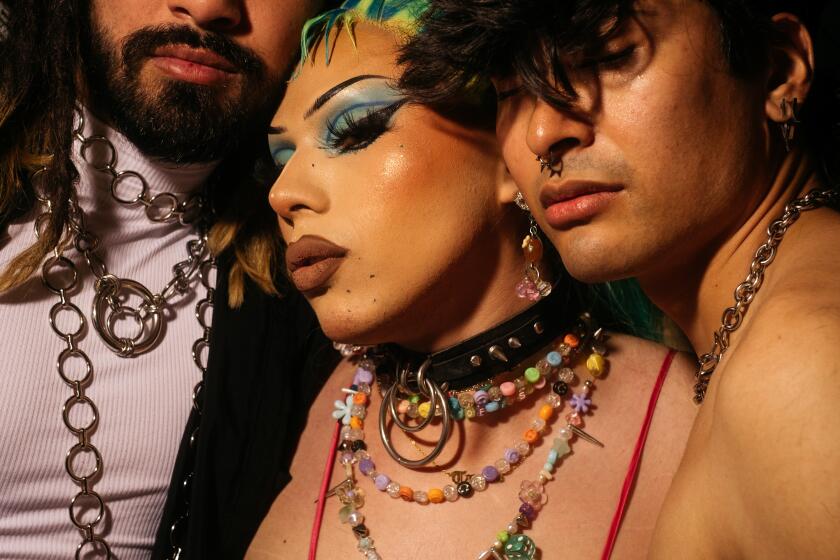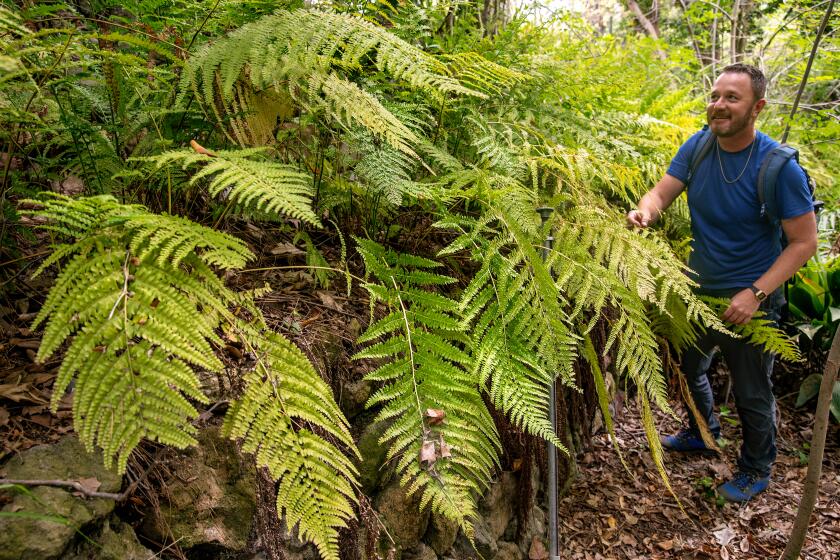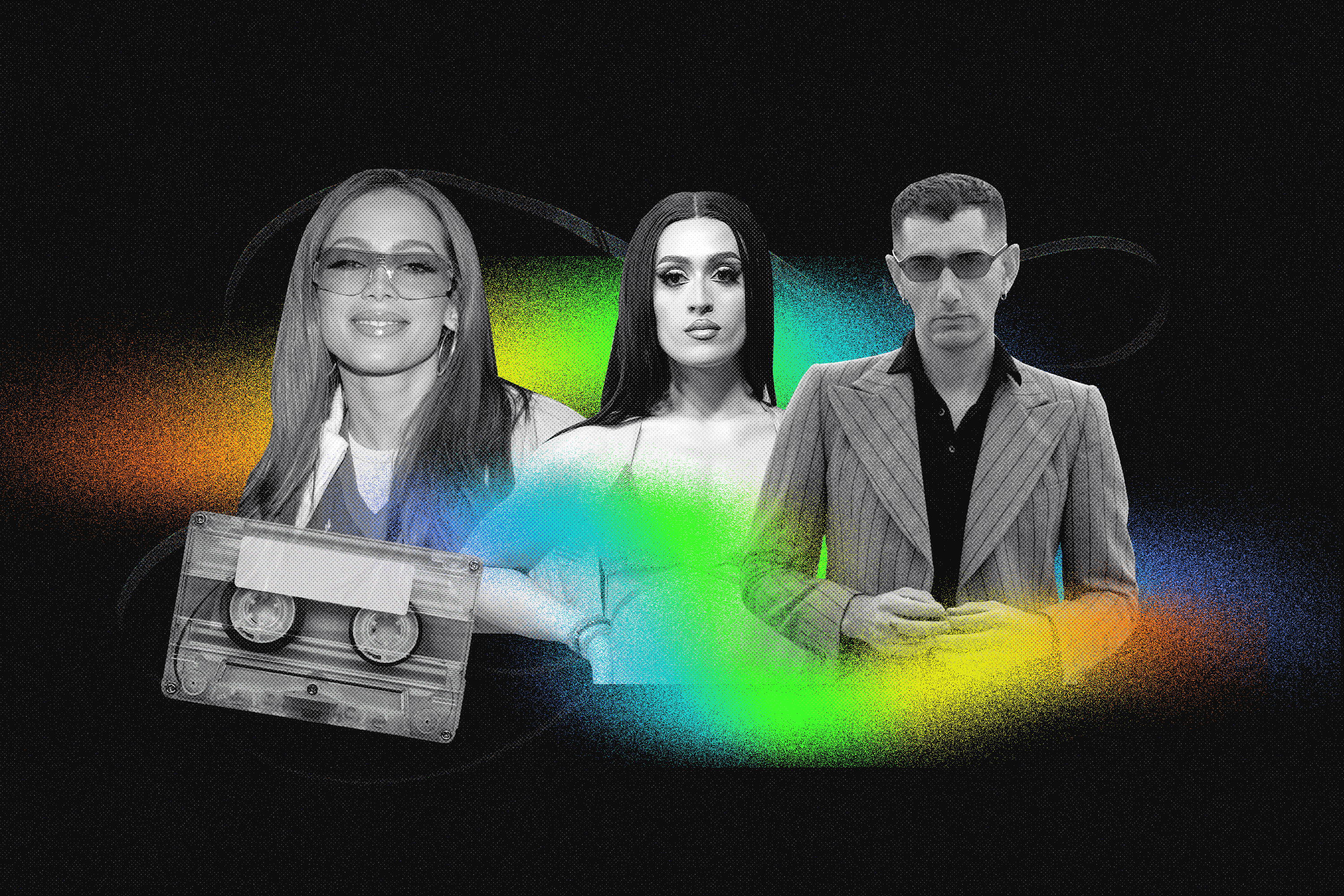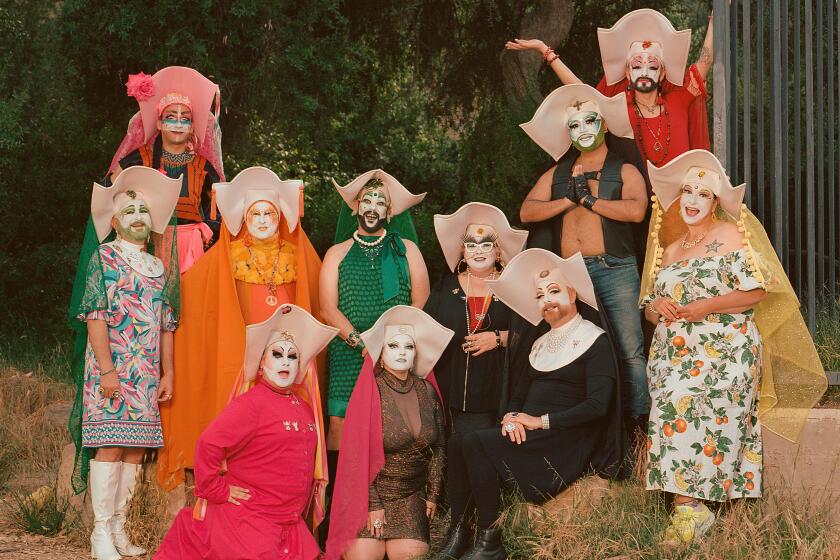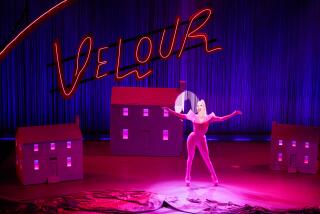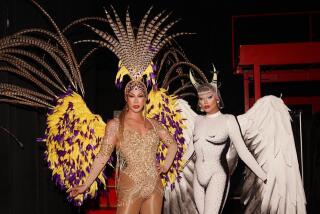When you hear the word “drag,” what comes to mind?
Do you envision a statuesque queen with a televangelist-style hairdo and sequined gown on the “RuPaul’s Drag Race” main stage? How about a drag king doing a passionate rendition of Frank Sinatra’s “My Way” with a merkin glued to their chest?
Or do you think of the anti-drag legislation that’s been introduced in at least 14 states in the last year? Maybe your mind goes to Los Angeles’ Sisters of Perpetual Indulgence, the drag nuns who were recently invited, then uninvited, and then reinvited to the Dodgers’ annual Pride Night?
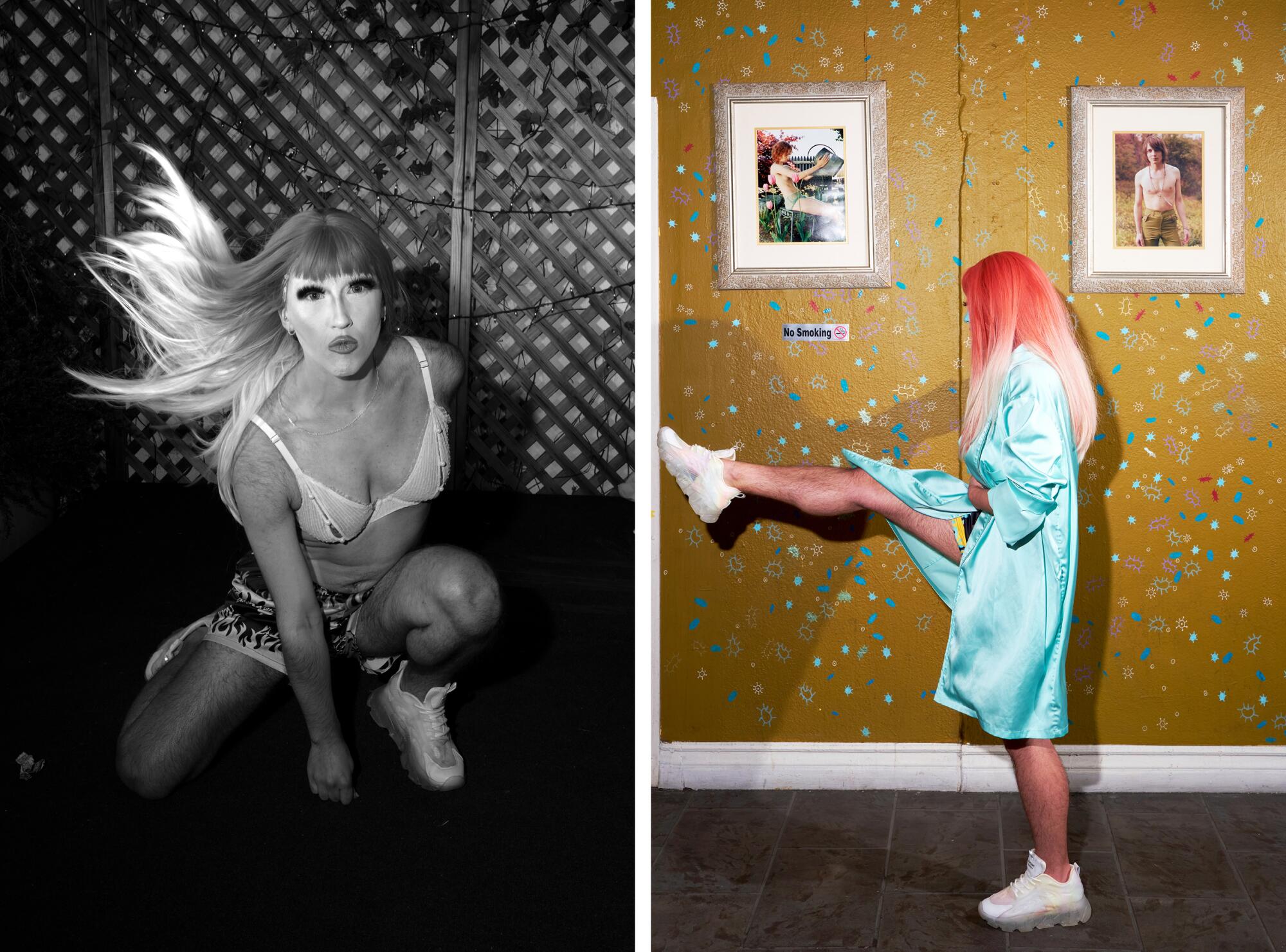
The art form of drag has clawed its way from underground nightlife into mainstream culture. In Los Angeles, Orange County and other parts of Southern California, drag has exploded over the last decade, and there are more drag queens, kings, monsters and things than ever before.
But it’s also as complicated as ever to be a drag performer.
While L.A.’s drag scene is thriving, it’s impossible to ignore the fact that drag shows across the country, even ones in liberal cities such as Los Angeles, have been targeted by far-right extremists, making them the latest pawns in an insidious culture war primarily targeting transgender people.
“Being in L.A., a major city, we do have a lot of privilege as drag performers,” said Twinka Masala, a Punjabi drag king who moved to L.A. from the Central Coast last year. “But that’s not the case even 20, 30 minutes outside of the city.”
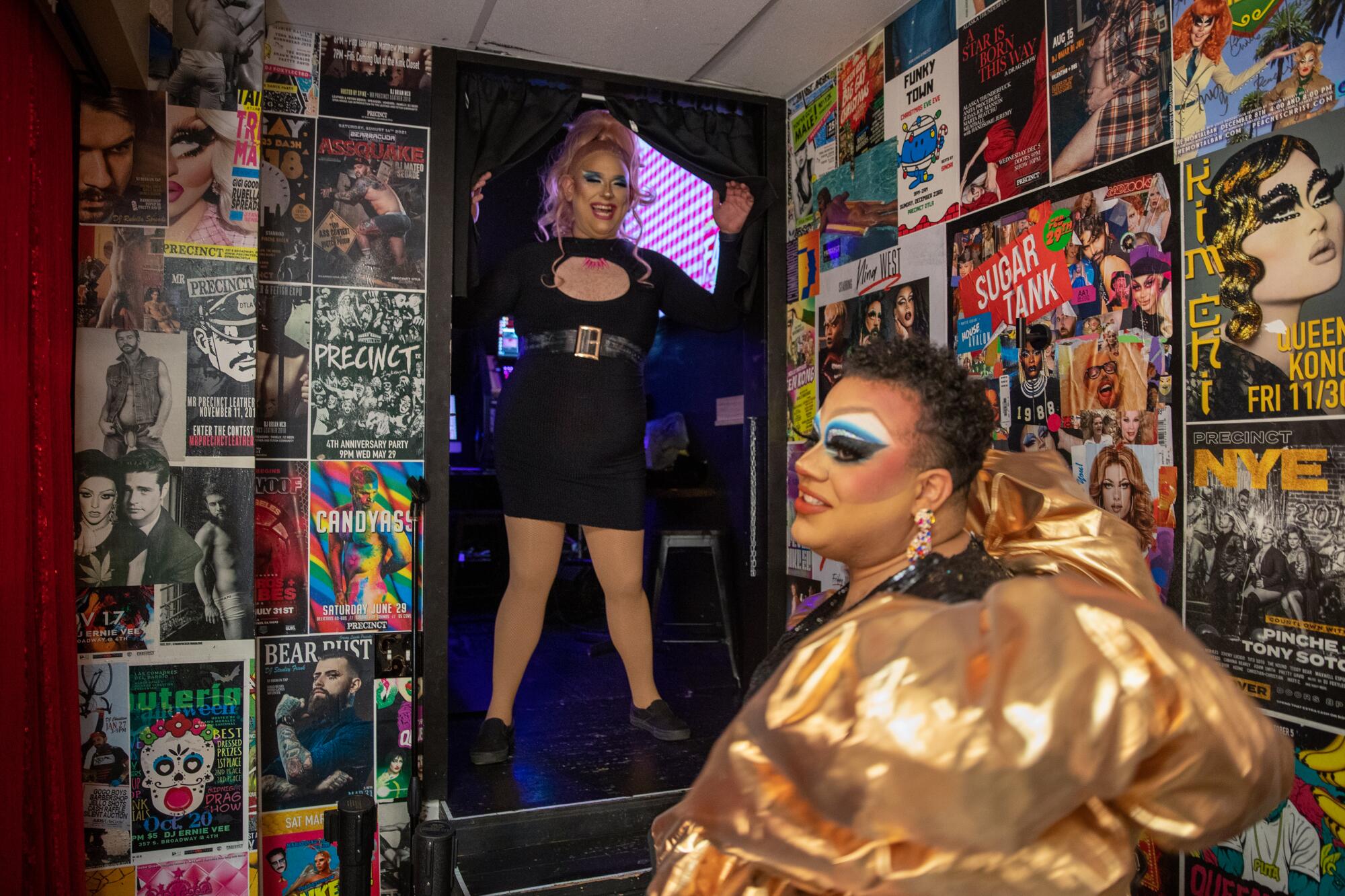
L.A. state of mind
L.A. has long served as an oasis for artists of all kinds, and drag is no exception. As far back as the late 19th century, vaudeville shows and early Hollywood films featured gender-nonconforming performers.
By the 1990s, L.A. drag had taken on a life of its own. Clubs such as Cherry and Makeup housed punk-rock legends in the making, Circus Disco in Hollywood gave Latinx drag queens a safe haven, and Dragstrip 66 in Silver Lake created a whole new community around its delightfully silly themed parties.
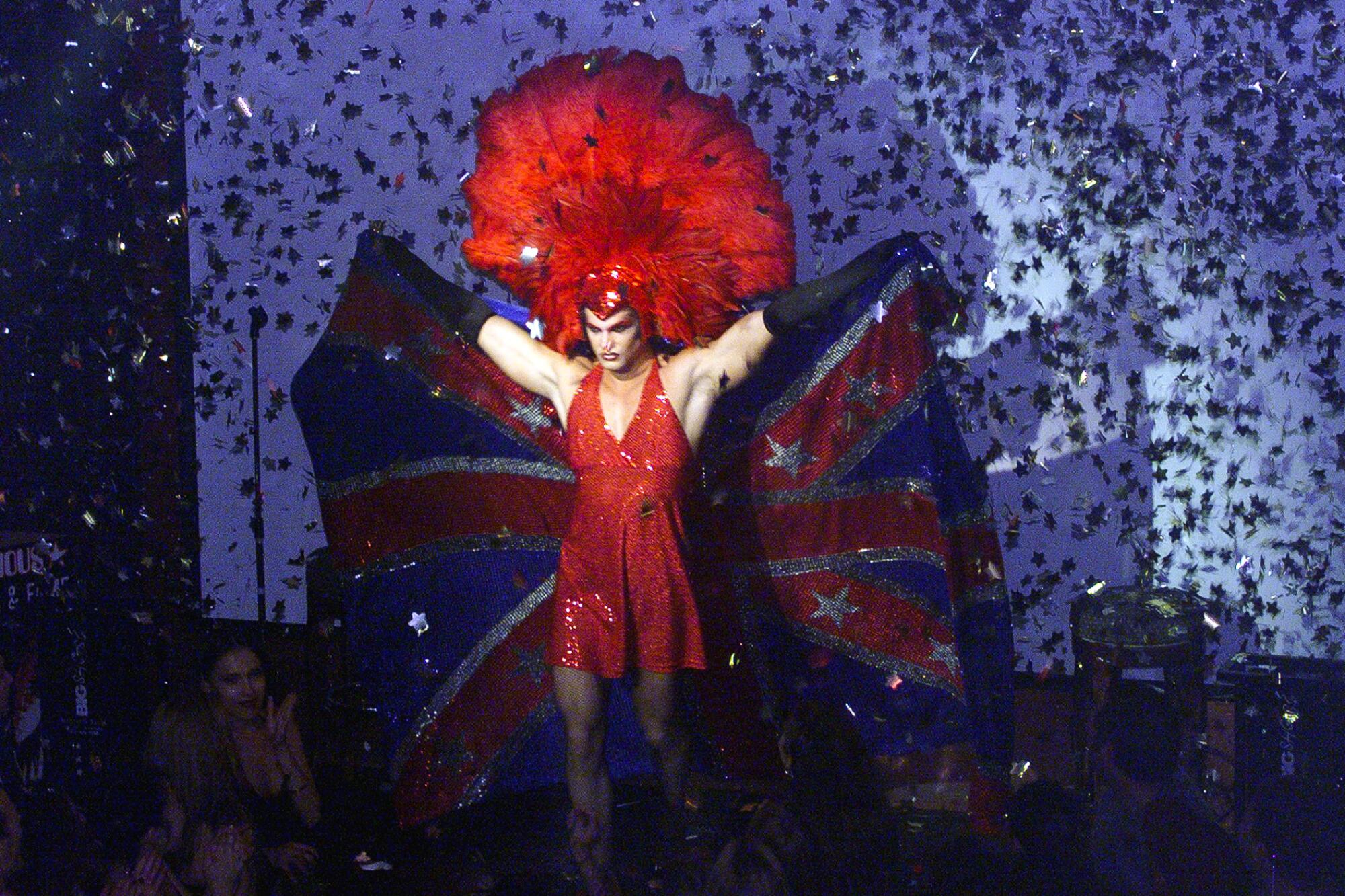
The drag scene quickly amassed a crew of local icons including Karen Dior, Jackie Beat, Alexis Arquette, Love Connie, Miss Barbie-Q and “Drag Race” alumni Raja Gemini, Detox, Alaska and Willam.
The Sisters of Perpetual Indulgence, who have been community leaders in L.A.’s drag scene since 1995, recently were thrust into a national spotlight when the Catholic League and Sen. Marco Rubio (R-Fla.) convinced the Dodgers’ leadership that it was “rewarding hate speech” by honoring the group with an award.
At Heav3n, the fabulous, spooky and weird party people find nirvana. Walk through the gates of this queer-friendly L.A. dance party and free your inner devil.
But when L.A. Pride, the LGBT Center and the American Civil Liberties Union pulled out of the event in solidarity, the Dodgers camp reversed its decision yet again. The drag nuns are scheduled to accept their award on June 16.
Sister Electra-Complex said she was taken aback when she saw an influx in donations, followers and allied organizations standing up for the Sisters.
“The very first thing that I felt, when all the community started standing up for us, was care,” she said. “I remember thinking, ‘Oh s—, wouldn’t it have been great if my own family had shown up in this way for me, like through my own life?’”
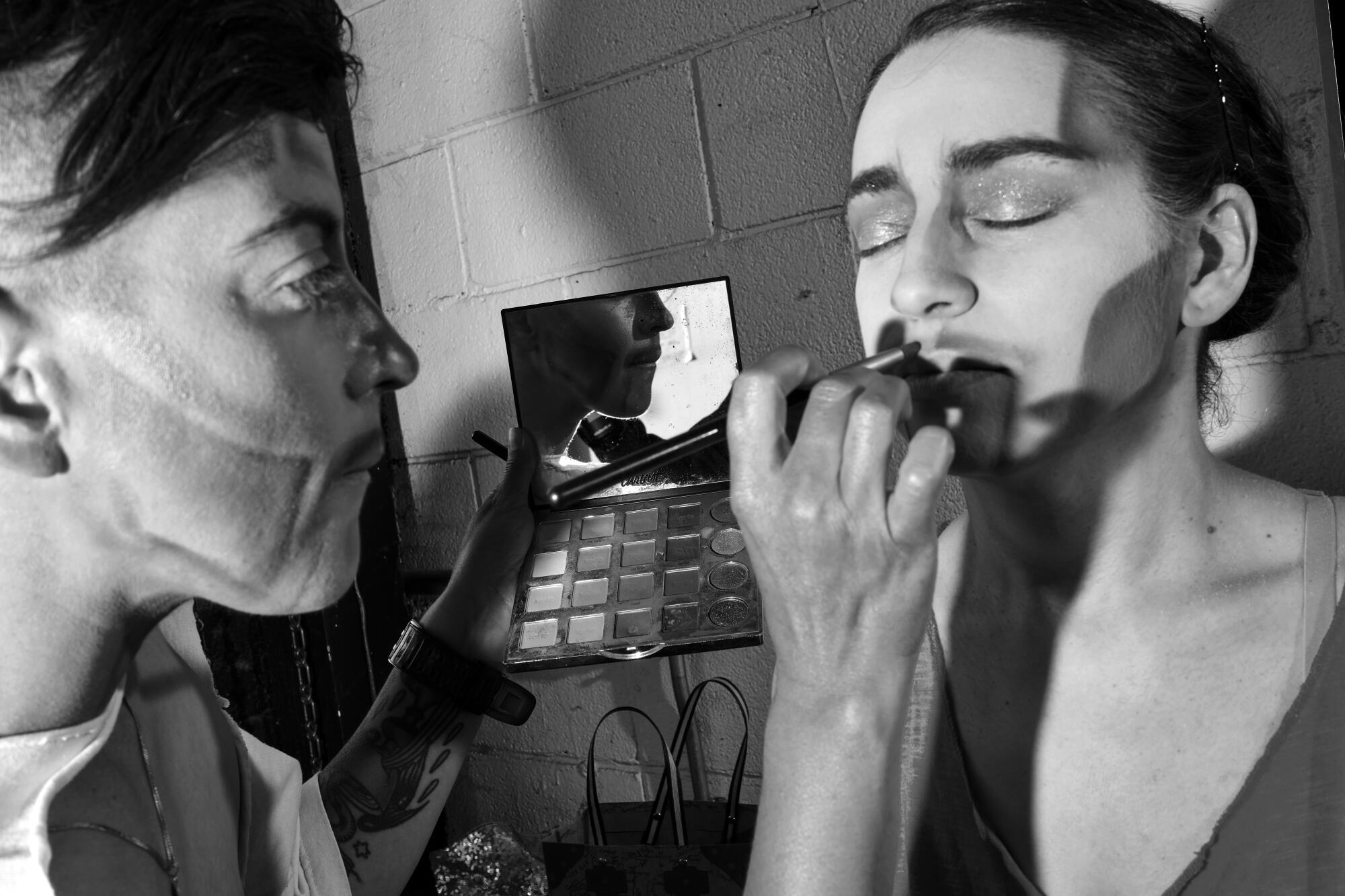
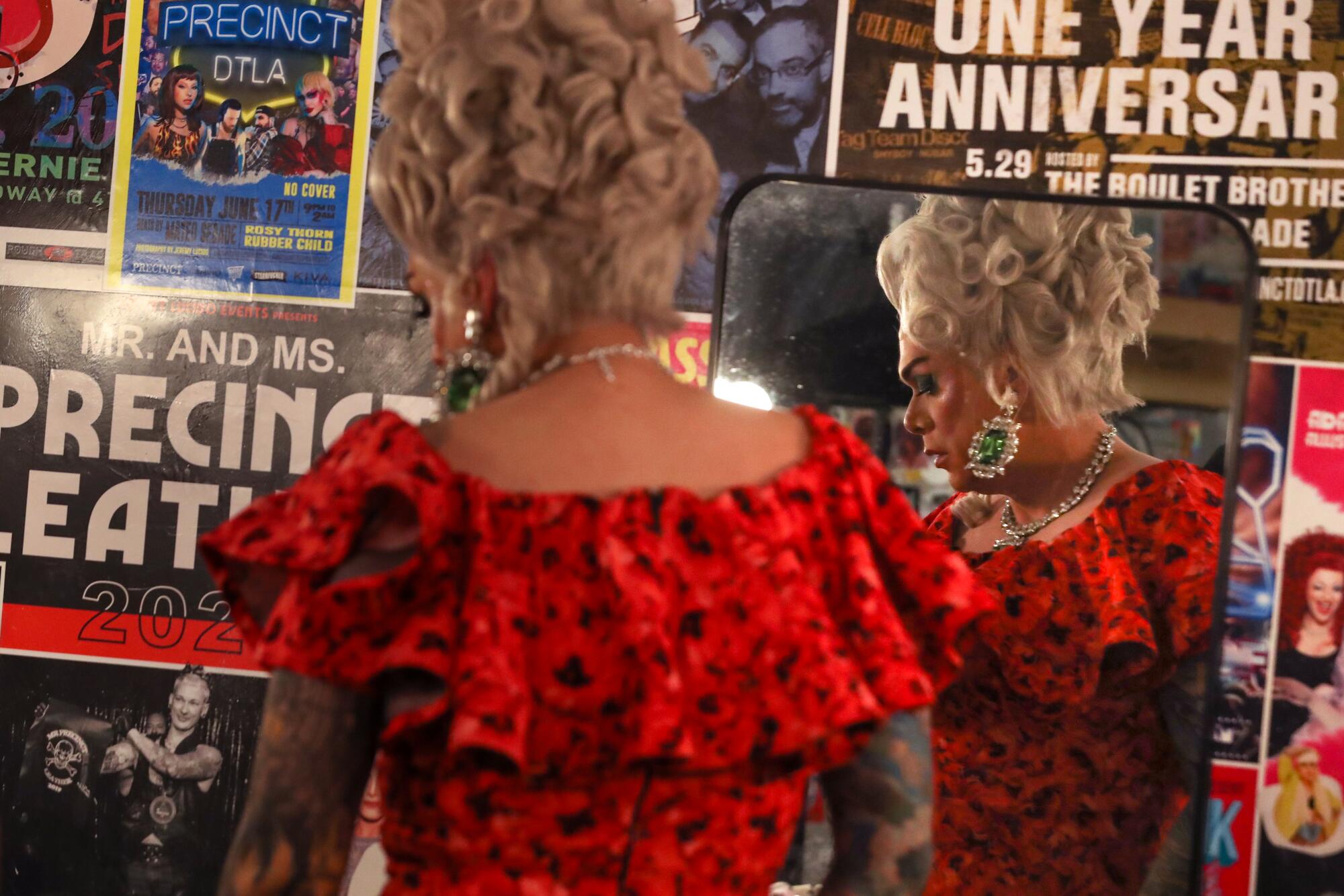
Part of L.A.’s awareness of drag must be attributed to “Drag Race.” Since the show’s premiere in 2009, drag has exploded in popularity. What was once a niche form of entertainment found in underground clubs is now everywhere: Postmates ads, techno raves, brunches, comedy shows, bookstores, college campuses and national parks.
Hershii LiqCour-Jete, a 31-year-old drag queen who moved to L.A. from Atlanta in 2017, said, “Because of ‘Drag Race,’ the scene is very commercialized” and “competitive,” noting a massive shift from the grungy reputation L.A.’s drag scene once had.
“The change that I’ve seen the most is I hear more people bitching about not getting booked,” said Silver Lake drag emcee Tony Soto. “There’s a ton of f— queens out there, and there’s only a select number of shows.”
More than ever before, L.A.’s drag scene is a melting pot of styles and attitudes.
“Drag previously was so localized that you could tell from someone’s drag what part of the country they came from,” said Jewels, a leading drag queen of Long Beach since 1998. “Drag doesn’t seem to be confined to an old-school niche like it may have been in the past.”
Miss Barbie-Q, who has been doing drag in L.A. since 1992, doesn’t see the art form’s rise in popularity as universally beneficial, especially for performers of color.
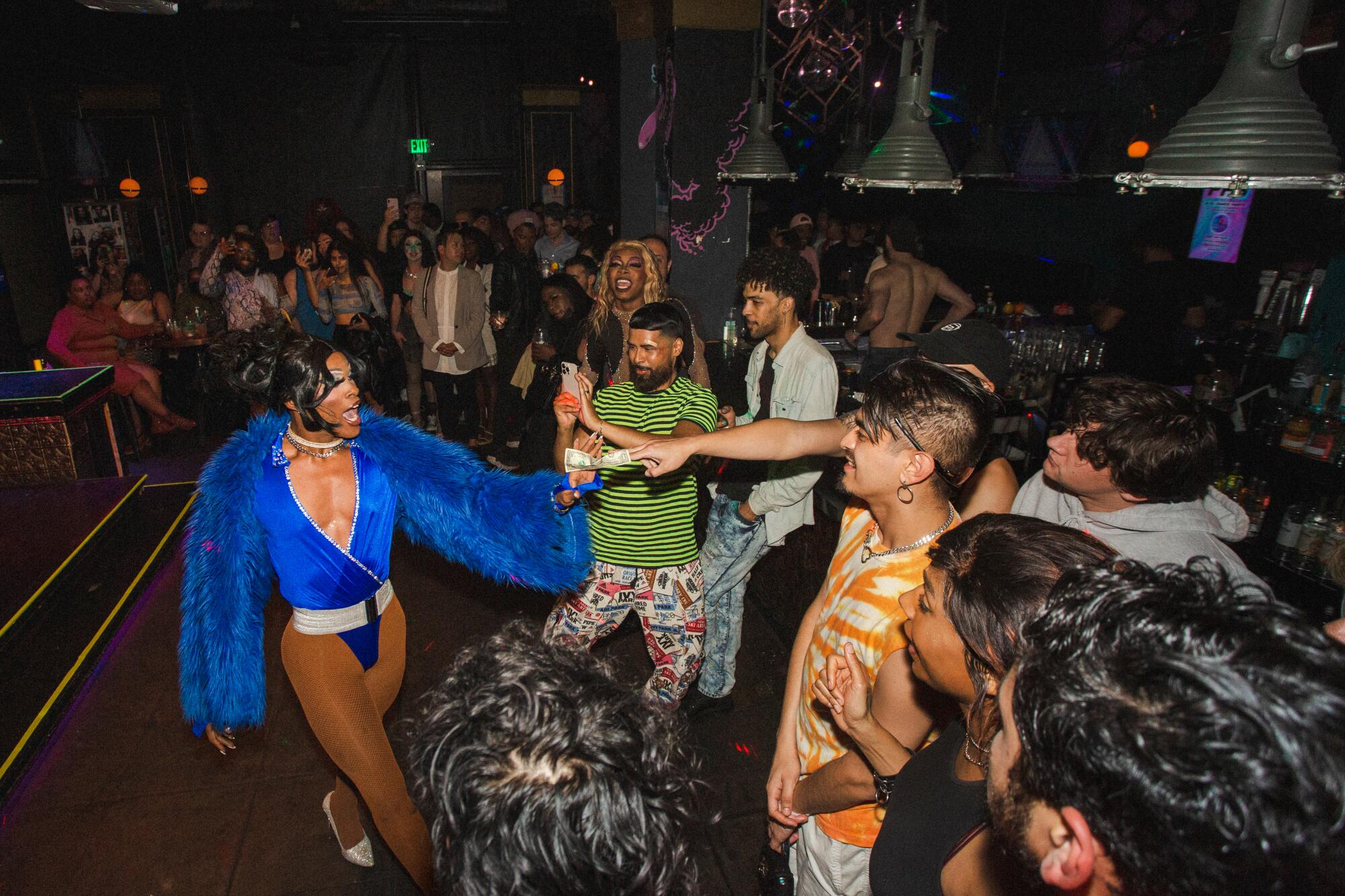
“The drag scene is flourishing for some,” Miss Barbie-Q said. “The drag scene is still a struggle for some, especially for a lot of Black and brown communities that are doing drag without the help of ‘RuPaul’s Drag Race.’
“When I came out as trans, I lost a lot of work as a drag queen,” Miss Barbie-Q continued. “Transphobia within the drag community is still there. Don’t get it twisted.”
Locally, Miss Barbie-Q might be best known as host of the downtown L.A. scene-shifting Mustache Mondays for its first five years. More recently, they have been reading at Drag Story Hours around L.A.
The current political climate has raised new concerns for Miss Barbie-Q about their safety.
“It does worry me, the hostility that has come up over the nation, and we cannot be naive,” Miss Barbie-Q said. “The more visibility we have, the more backlash we’ll get. I think it’s very naive to think, ‘Oh, we’re in Los Angeles, we’re immune to all that’s happening around the nation.’”
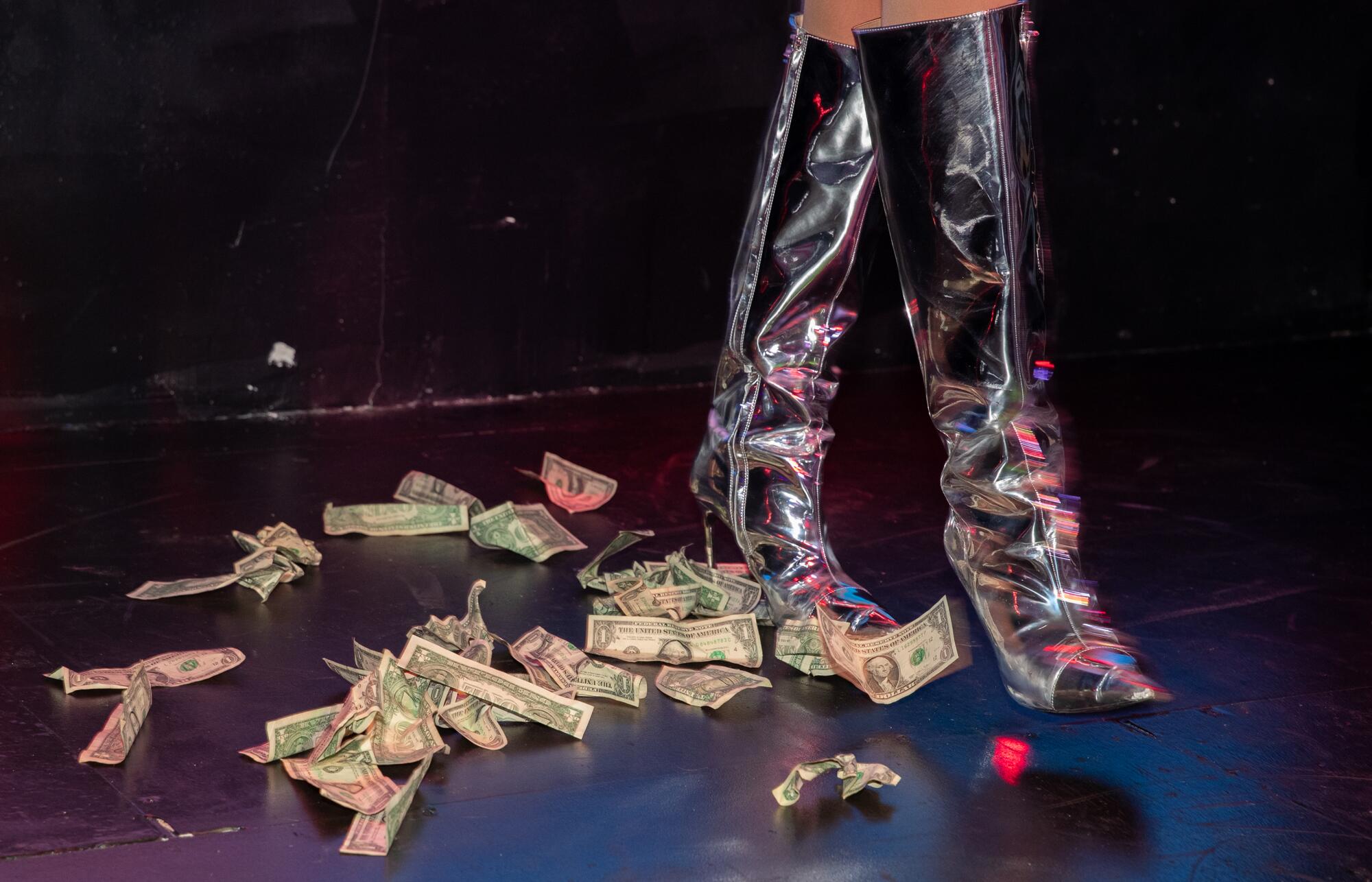
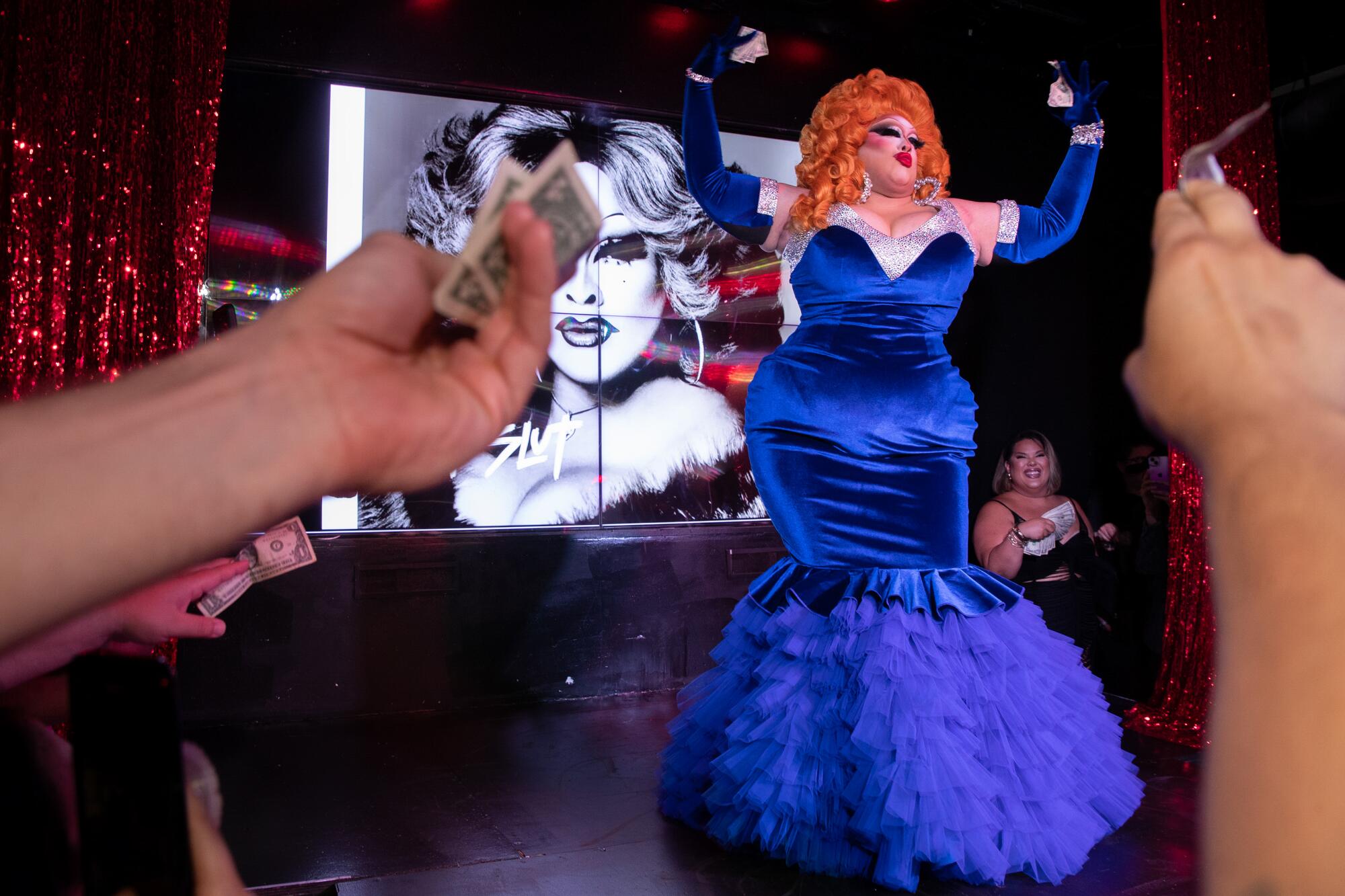
Downtown and underground
L.A.’s drag scene often is pinned to the strip of gay bars along and near Santa Monica Boulevard in West Hollywood, from brunch at the Abbey or Hamburger Mary’s to the famous Monday night Showgirls at Micky’s. But across town there’s another blossoming scene.
Every third Friday at downtown’s Precinct bar, drag queen Meatball hosts Fat Slut, which she described as a mix of a drag show and a “sexy eating competition.” The party began after pandemic shutdowns in 2021.
For Jason Wise, knowing more about the natural world could’ve fortified him growing up in a conservative religious community. Now he’s sharing his queer ecology knowledge on hikes for Pride Month.
“I wanted a place for people that don’t want to identify with any subculture — or if they do, they don’t care,” Meatball said. “A place for everybody to come hang out and be happy with their bodies and feel no shame.”
Since then, the party has become well-known for its quality performances against a picnic tablecloth backdrop as well as Meatball’s side-splitting banter and physical comedy (which typically involves her slipping on food scraps and falling to the ground at some point in the evening).
Less expected, however, has been the bonding.
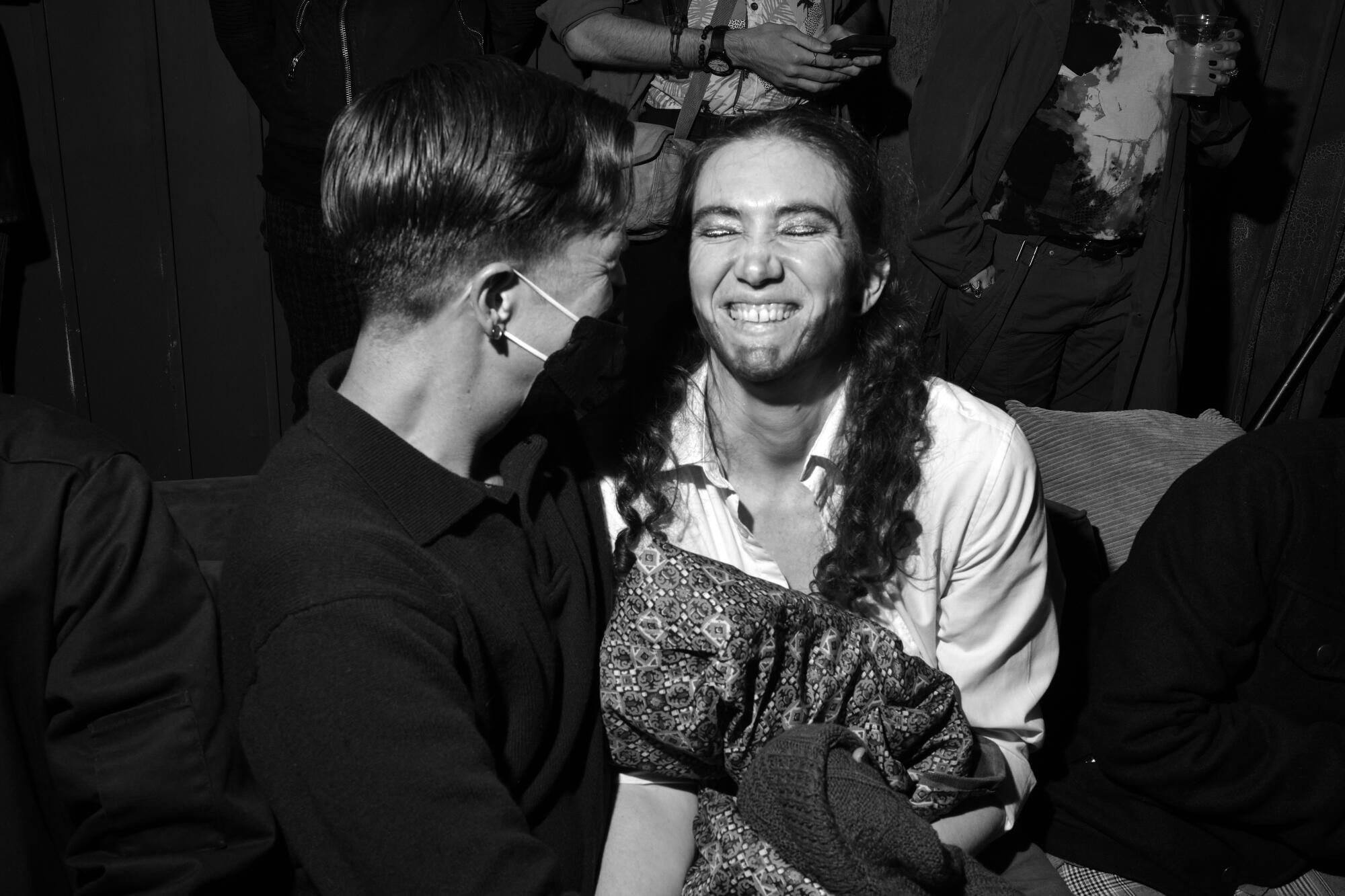
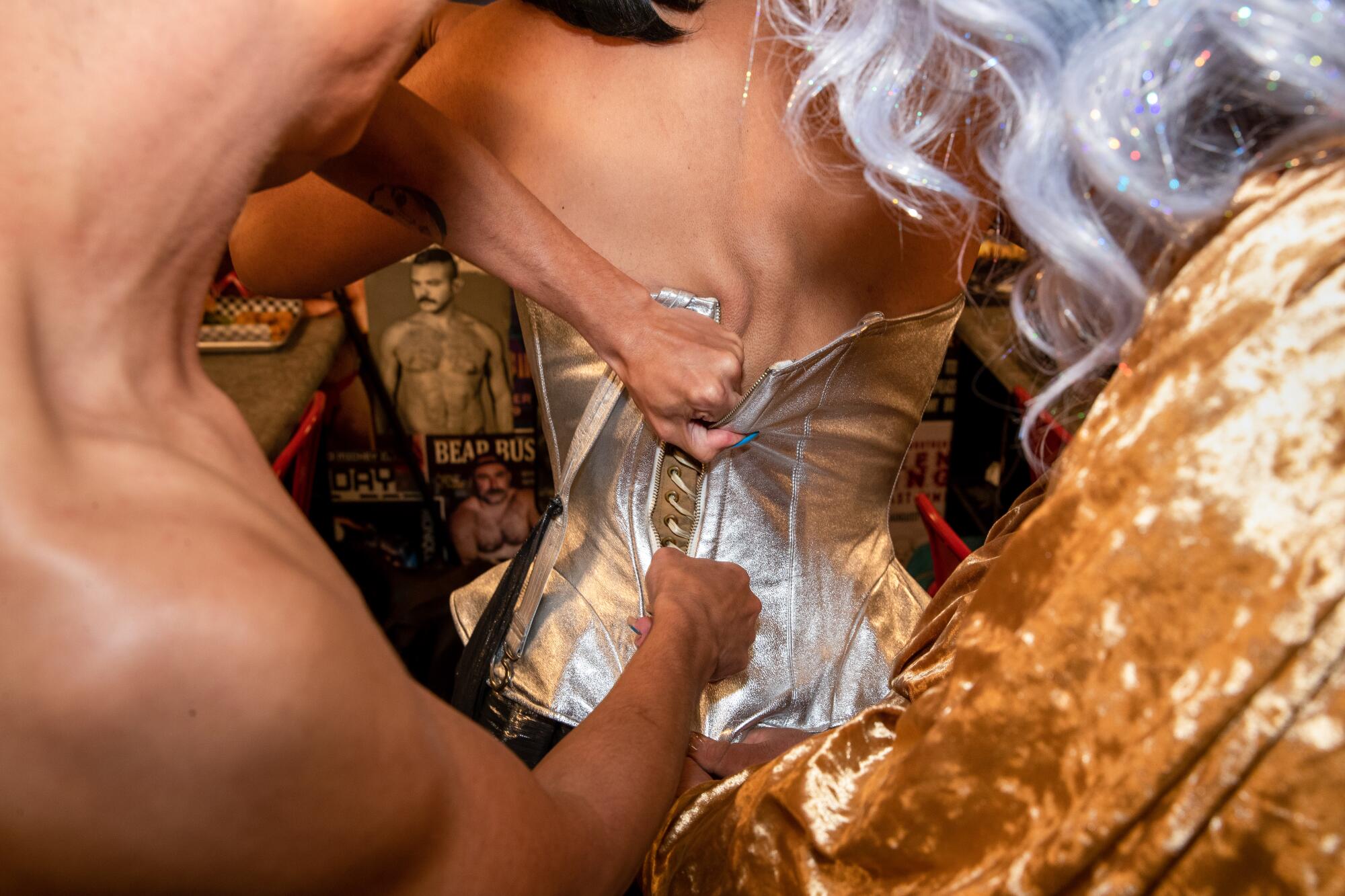
“I didn’t think about it as community-building until I was talking with the bar about it,” Meatball said. “It feels like I’ve seen these people for the whole eight years I’ve been doing drag, but for the first time I’m getting to know them, and it feels like a family. And when they aren’t there, I’m like, ‘Oh, I should check on them.’”
According to Meatball, the party has strong bar sales and attendance records at Precinct, a sizable space that has seen lines around the block for its blockbuster weekend drag parties including House of Avalon’s Sugartank and the now-shuttered Queen Kong, which was hosted by the Boulet Brothers.
A few blocks away at Redline, which is a fraction of Precinct’s size, a different mecca exists for up-and-coming drag performers. Some of the drag legends who have graced Redline’s modest stage, including reigning “Drag Race” winner Sasha Colby, appear on the walls in giant purple murals by artist David Puck.
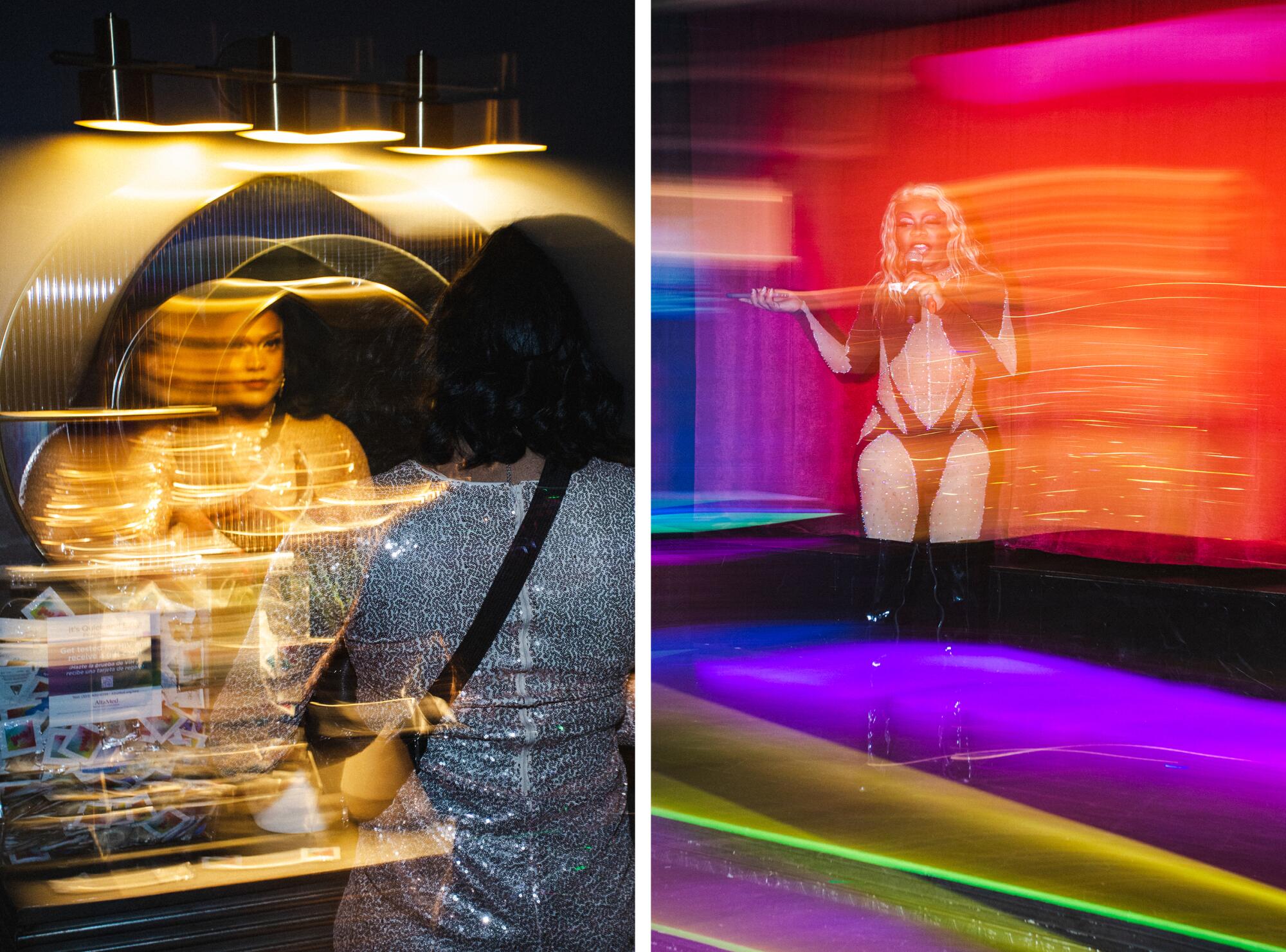
The bar is home to several shows, including Serena Infiniti-LiqCour’s Black Girl Magic and 28-year-old Siri’s Fake Smart, a drag variety show that began on Instagram in 2020 and has since become a downtown L.A. favorite.
Held on the third Thursday of the month, Fake Smart has evolved to feature absurd themes such as “breakfast” and “unprofessionalism.” In April, Siri turned the show into a one-night-only scripted play about the Miss Chobani Yogurt pageant, in which contestants were being ritualistically offed by a mysterious hit man.
Deeper underground in the L.A. drag scene reside the monsters, things and punk acts that have recently been popularized by the Boulet Brothers’ Dragula, an alternative competition series that began as an L.A. bar show and now airs on the streaming service Shudder. The performers’ makeup is usually more cartoonish or scary than your average drag queen, and they’re rarely seen on the stages of West Hollywood.
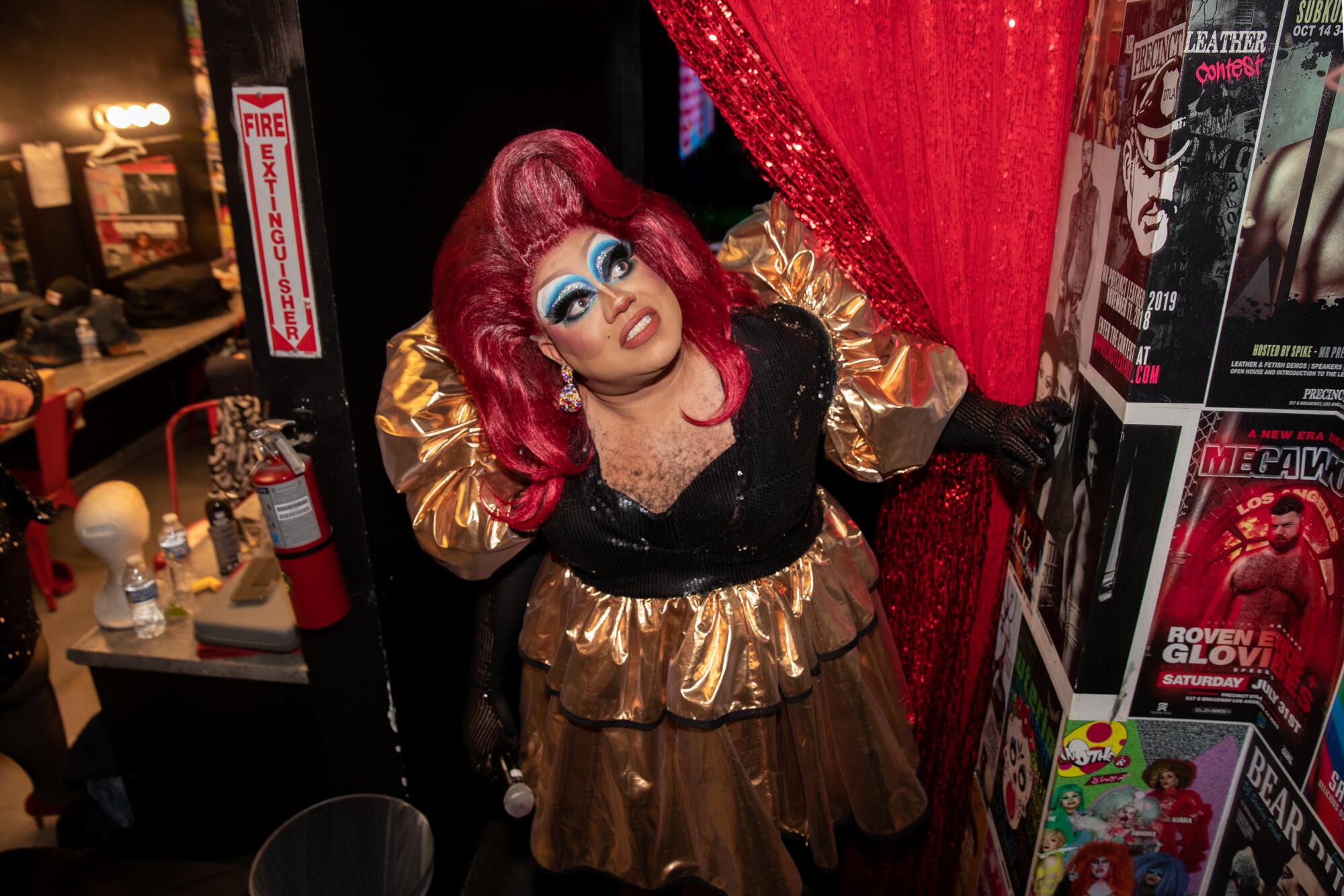
L.A. has long been home to such fringe acts (think performers who staple dollar bills to themselves and opt for Metallica over Katy Perry), but the scene has become more transient in the wake of several venues such as Club Scum and East Hollywood’s Faultline Bar recently going dark.
“We felt the lack of an alternative drag scene in the community,” said Dusk, a 32-year-old drag artist who co-produces She’s in Parties, an alternative goth night at Precinct that is one of the only experimental drag shows of its kind in L.A.
A number of songs by LGBTQ+ artists to get your blood pumping and your hearts singing in time for the festivities.
“It has to be kind of spooky, kind of creepy, and that’s kind of how I like it,” Dusk added. “It’s all performance art and it’s something that has a little more substance than a traditional high-kick-and-splits kind of performance that you would see in other places.”
Goth, grunge and punk drag artists also have found a home in warehouses and after-hours events such as the kink-centered Safeword and the Mexico- and L.A.-based rave Por Detroit, where Dusk also performs.
“Drag plays a really big part in those spaces,” said Succubus, a drag DJ and performer whose work often transcends the boundaries of gay bars. “You can go to any kind of event, but once you see a drag queen there, a lot of people are able to let their guards down a little bit more and have fun.”
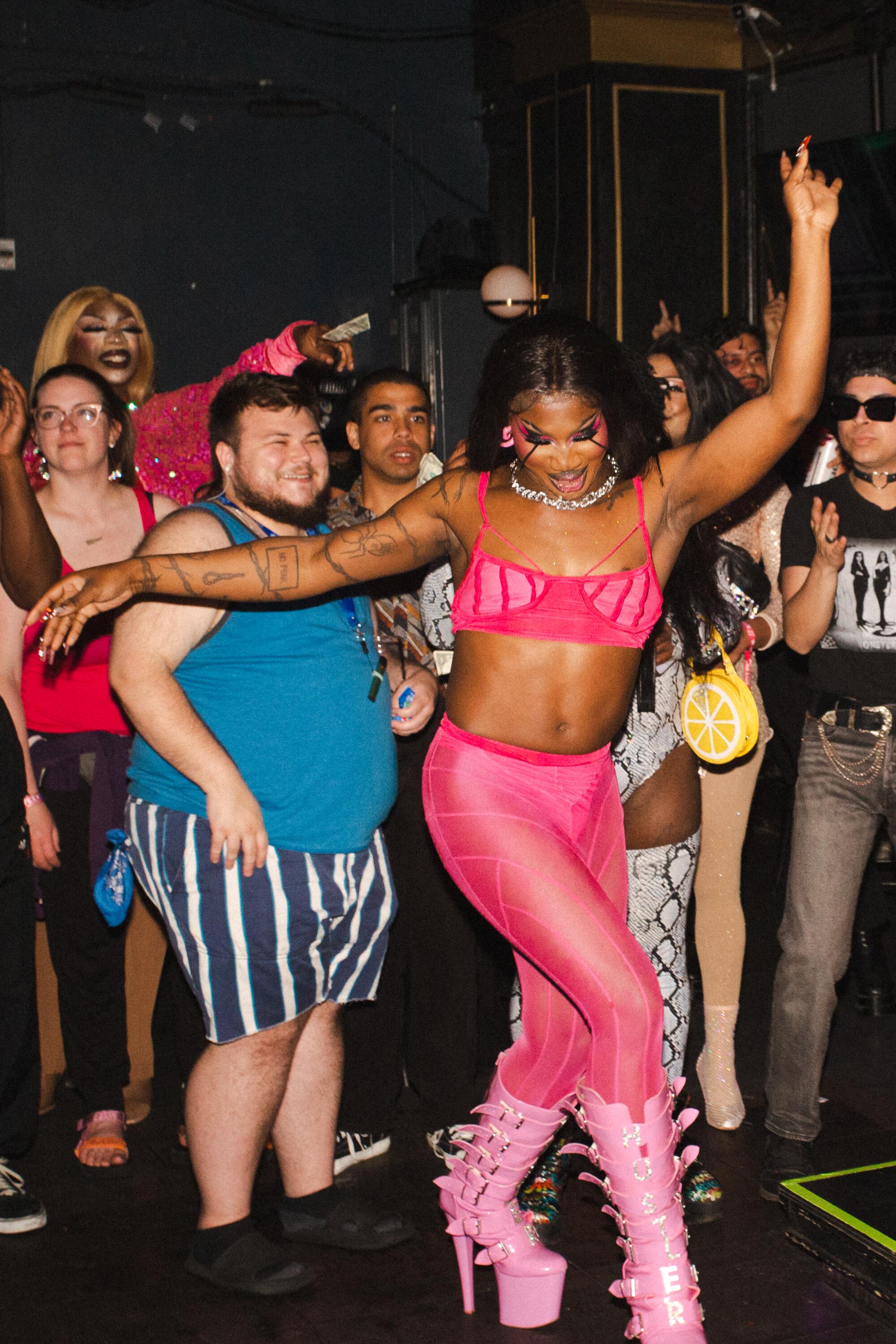
‘Drag is rebellion’
Leandra Rose, 27, has been performing and hosting all across Southern California, from Palm Springs to San Diego, for 10 years. She describes her drag persona as a “very Latina, very feminine, Mexican woman.”
“Everybody loves a Latin number,” she said.
About half of L.A. County is of Hispanic or Latino descent, but she says the local drag scene doesn’t necessarily reflect that.
Venues such as Club Tempo in Hollywood, the New Jalisco Bar in downtown L.A., Alibi East in Pomona and Solita in Santa Ana have kept the tradition of Latin drag alive, but it still exists in the margins of L.A.’s LGBTQ+ community.
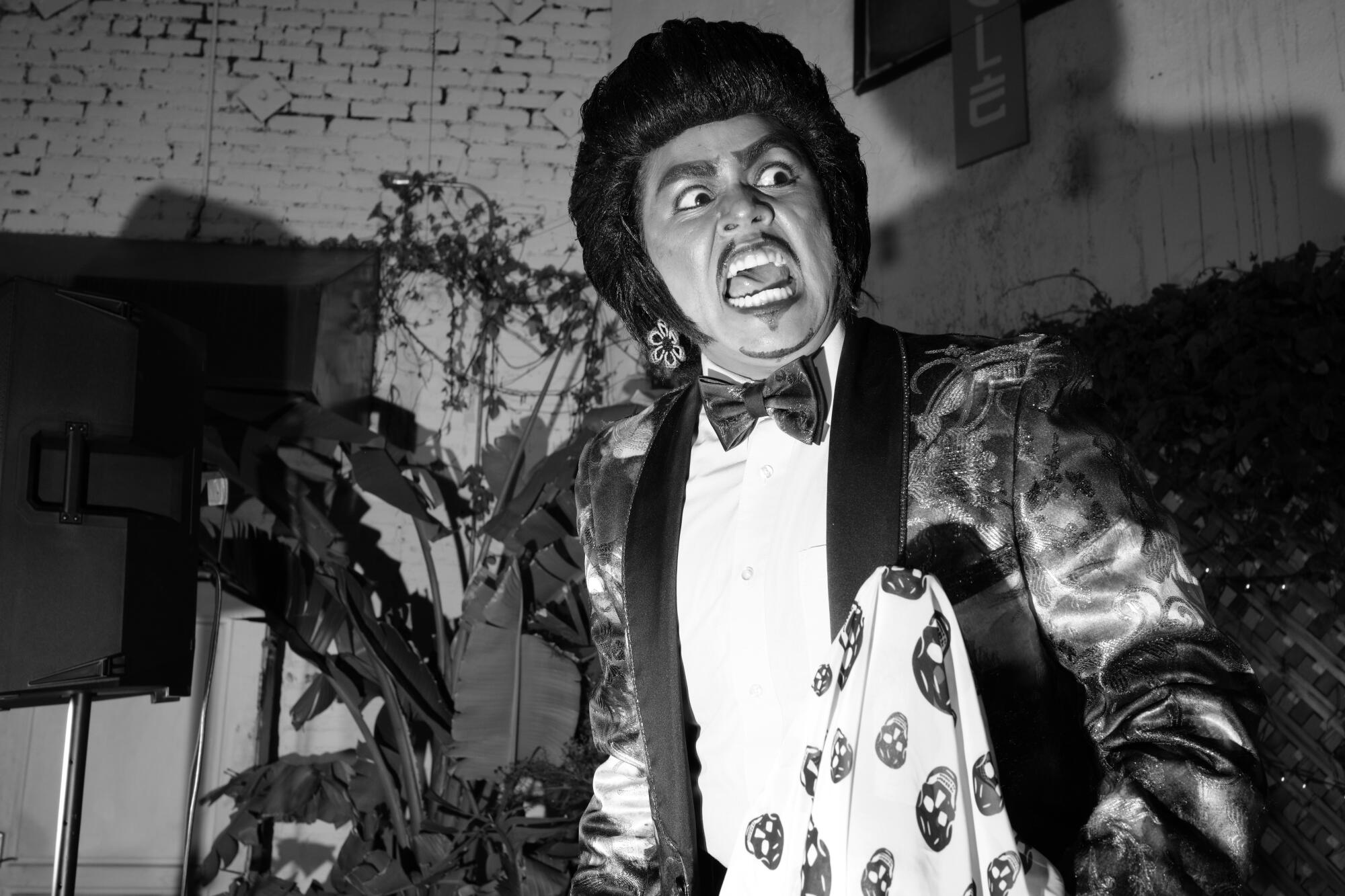
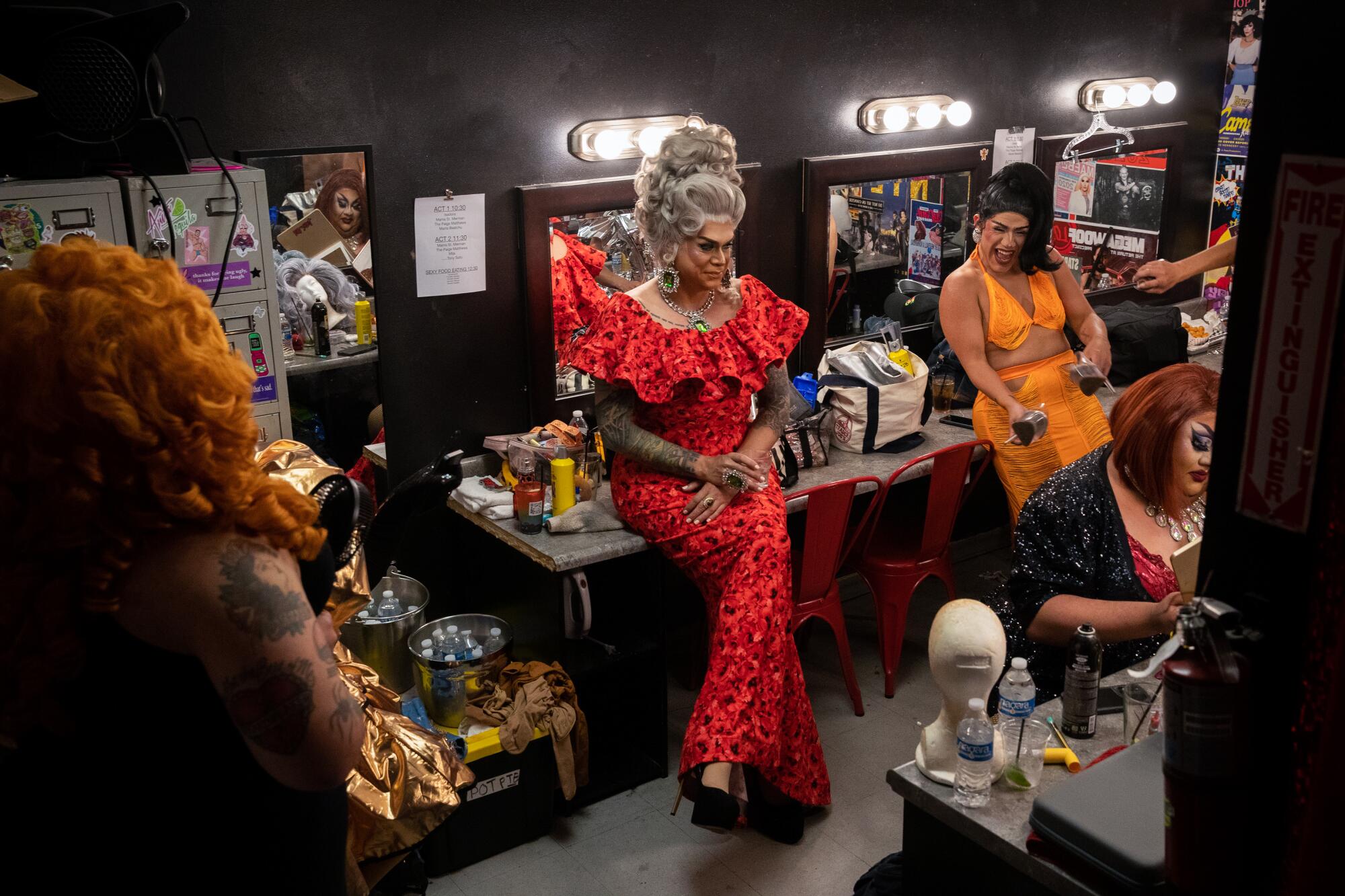
However, Leandra Rose, who competed on the Mexican YouTube series “La Más Draga,” also said she’s noticed an increase in Latina drag queens thanks to shows like that and the upcoming “Drag Race México.”
“We have a lot of community that are fans of drag that don’t speak English,” said Leandra Rose, who moved to California 13 years ago from Progreso, Mexico. “That’s why we need to have more Latin venues or Latin shows going on — for those people.”
For the Los Angeles Sisters of Perpetual Indulgence, it’s about comforting those in need, Pride award or not. After the Dodgers tumult, the drag nuns reflect on their ministry.
Across L.A., several other local communities are fighting to increase their drag footprint.
Miss Shu Mai, a Taiwanese American queen based in the San Gabriel Valley, has been co-producing an Asian American and Pacific Islander drag party called Send Noodz with fellow queen Bibi Discoteca since 2018.
“It was born really out of me seeing that I was usually the only Asian cast [member] in any show I was cast in,” said Shu Mai. “The magic about it is that almost every time, someone tells me that this space is necessary for them — that it’s been healing for them — because it’s a space where they really feel like they can be all of them, not just parts of themselves.”
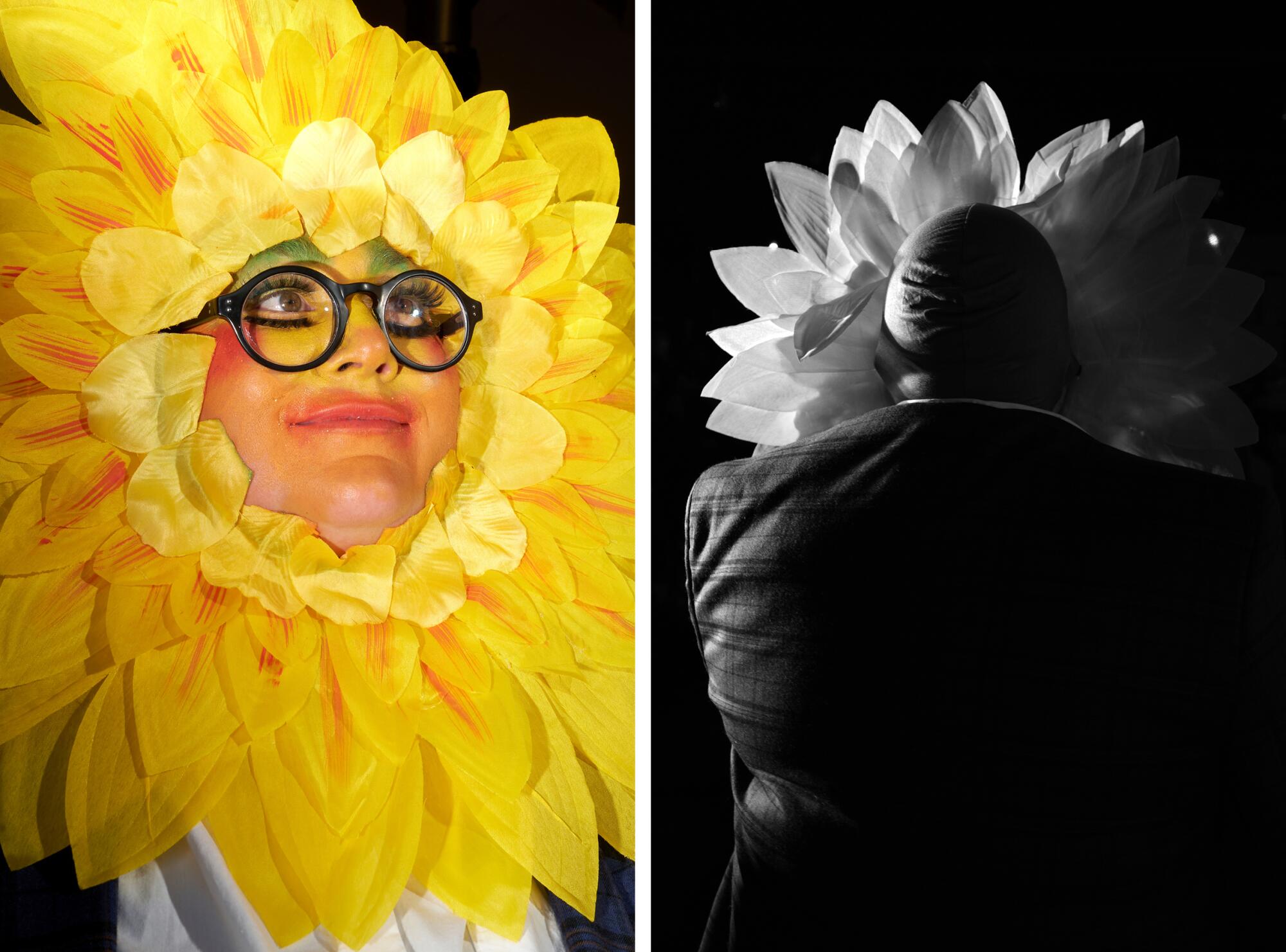
The representation is necessary, Shu Mai said, because the L.A. drag scene has seen acts of yellowface as recently as last year. Filipino American drag king Skirt Cocaine said they have witnessed blackface and non-Black performers using the N-word in lip-sync performances.
“Show producers and clubs in general, they should have a responsibility of maintaining a safe space, and part of that is addressing when things are f— up,” Skirt Cocaine said. “Because if you don’t, then you’re curating a space where people think it’s OK to be abusive, which is not what you want.”
Skirt Cocaine said they were seeing progress among new shows that centered around people of color and drag kings, but since the pandemic, they have seen less diverse lineups returning to the scene.
“Drag kings are just as talented and should have an equal opportunity as any drag queen in Los Angeles,” said Johnny Gentleman, a 31-year-old king who made a public Google form last year to compile L.A.’s kings in one place. The list has 44 entries so far.
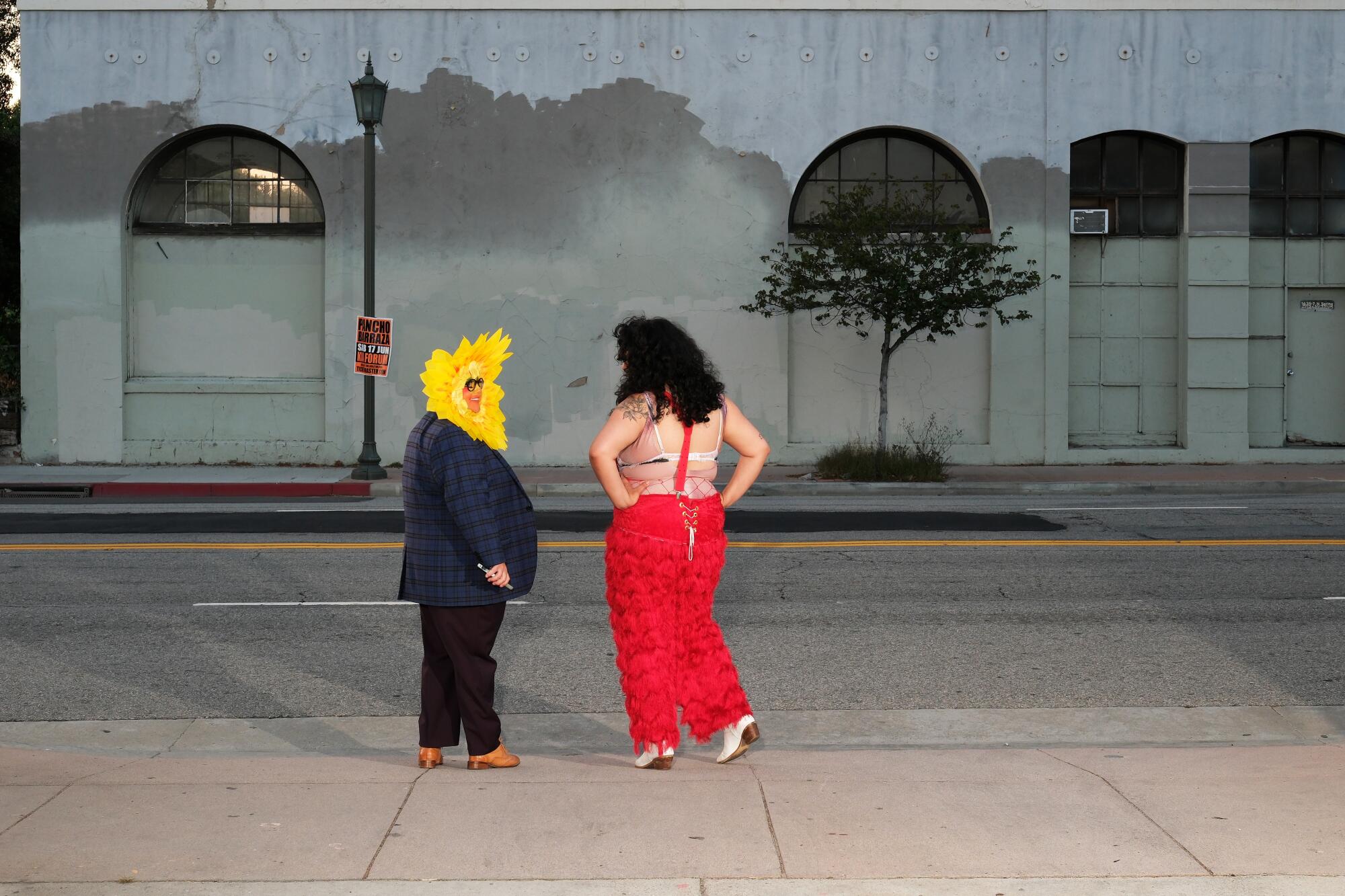
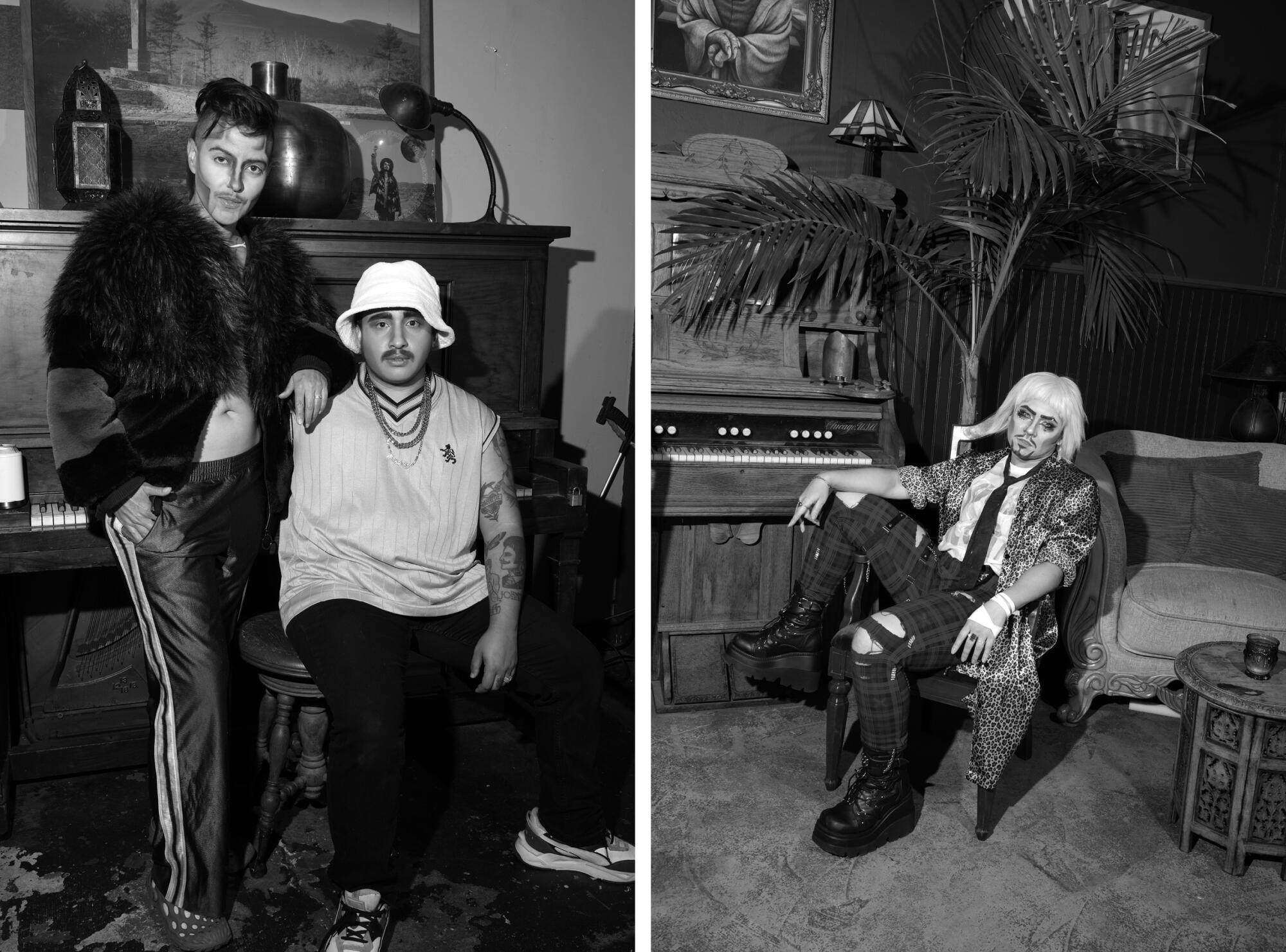
Johnny Gentleman, who is trans and of Indigenous descent, said he hadn’t felt targeted as a drag artist until a couple of months ago when he was leaving a gig in West Hollywood. He said two men drove by in a car and began verbally harassing him.
“They started saying that I deserve to die, that they were going to kill me, that I am going to burn in hell,” Gentleman said. “Luckily there were people around, and they were defending me and telling them to go away.”
Although he made it out of that situation safely, he said it shifted his perspective on the political climate in L.A. and why it’s important for drag performers to stay unified.
“We as a community need to put our egos aside and understand that in order for us to be strong, we need to be strong together,” Gentleman said. “Drag is rebellion. We just need to bring that into reality.”
More to Read
Sign up for The Wild
We’ll help you find the best places to hike, bike and run, as well as the perfect silent spots for meditation and yoga.
You may occasionally receive promotional content from the Los Angeles Times.
